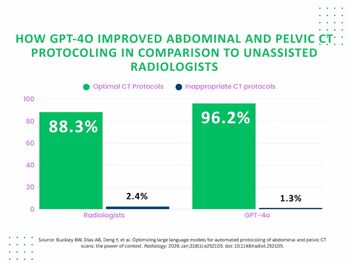
Database mining shows CT scans stable in children, climbing in adults
Researchers using a massive database of radiology reports to identify 10-year trends in scanning practices found mixed results. The good news: CT scans of children increased only slightly. In adults, however, they increased more than 50%, with abdominal and chest scans leading the way.
Researchers using a massive database of radiology reports to identify 10-year trends in scanning practices found mixed results. The good news: CT scans of children increased only slightly. In adults, however, they increased more than 50%, with abdominal and chest scans leading the way.
The study was reported Monday in an informatics scientific session that focused heavily on the emerging use of databases to better understand trends in imaging practice.
Other papers in the session used database reviews to:
- identify the frequency of wrong side statements in radiology reports
- automate the process of following up on image findings to facilitate personal quality assurance
- automatically draw out radiology workflow process information from RIS, PACS, and speech recognition systems
- mine hospital-wide information systems for patient information
- mine digital chest radiographs for quality deficiencies
Digital information in radiology is moving from an age in which it was simply acquired to one in which it is analyzed, said presenter Dr. Paul Nagy, an associate professor of radiology at the University of Maryland.
The review of CT scans covered more than 630,000 reports in nearly 200,000 patients at Massachusetts General Hospital for a 10-year period beginning in 1996. Researchers performed cross-tabulations and multivariable regressions to determine the number of CT exams per patient; factors associated with multiple exams per patient; and changes over time in age, sex, number of scans per patient, and body regions examined, said researcher Dr. Pragya Dang.
The number of CT exams per patient increased significantly during the 10-year period, from 1.7 to 2.3 per year. The growth for children was significantly less, from 1.66 to 1.73 exams. In adults, the number of exams went from 1.7 to 2.6. Abdomen and chest, at 68%, contributed the most to multiple exams, defined as more than five per patient.
Another paper, also presented by Mass General researchers, relied on a search engine scan of more than one million radiology reports to show trends in laterality errors in radiology reports. The researchers used the search engine to identify reports that included the terms left, right, and addended in both the body and impression sections. The reports were narrowed down to 88 that had laterality errors in the body, the impression, or the image.
Among the reports that were addended, mammography was the most common. Among those unaddended, the most common errors were in CT and radiography reports.
Newsletter
Stay at the forefront of radiology with the Diagnostic Imaging newsletter, delivering the latest news, clinical insights, and imaging advancements for today’s radiologists.




























